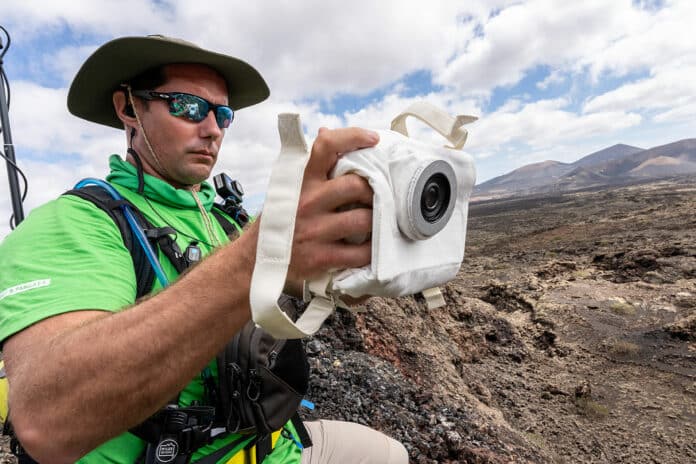European astronauts and scientists are lending a helping hand to NASA’s Artemis imagery team to develop the best camera for taking pictures of the Moon’s surface when astronauts return to the Moon.
NASA and ESA are testing the new Handheld Universal Lunar Camera (HULC) in the lunar-like landscapes of Lanzarote, Spain, as part of the PANGAEA training program. PANGAEA prepares astronauts to become effective field scientists for future missions to the Moon.
The new lunar camera is built from professional off-the-shelf cameras with great sensitivity to light and state-of-the-art lenses. The cameras used for HULC were modified to withstand extreme conditions on the moon. The modifications include adding a blanket for dust and thermal protection – temperatures range from minus 200 to 120 degrees Celsius on the Moon. Also, a new set of ergonomic buttons was added to ensure easy operation for astronauts while wearing gloves in bulky spacesuits.
“The lunar camera will be one of many tools they will need to handle on the Moon, so it should be easy to use. The human factor is a big deal for us because you want the camera to be intuitive and not taxing on the crew,” explains Jeremy Myers, NASA’s lead for the HULC camera.
During their field science training, the team of engineers conducted experiments to test the camera‘s performance in simulated lunar conditions. The tests were conducted in environments that resembled the extreme conditions of the lunar environment, including broad daylight and dark volcanic caves.
One objective during PANGAEA was to select the most suitable lenses and corresponding settings. They experimented with the camera in the field to make sure the photos had the right resolution, depth of field, and exposure to maximize science results.
The Apollo 11 mission camera was a standalone, mechanical Hasselblad with a Harrison Schmidt 60-millimeter lens, and it did manage to snap images of the moon. During the entire mission, the astronauts collected 1407 photos from four of these cameras.
On the other hand, the HULC will be the first mirrorless camera for handheld use in space. The Artemis Moon camera will provide excellent image quality in low light situations, making it well suited to the challenging, high-contrast environment of the Moon. The camera will also record videos, which can provide situational awareness to the ground teams and help document the exploration of our nearest cosmic neighbor.
The Artemis III mission will land on the South Pole of the Moon, close to permanently shadowed craters where the crew will look for evidence of water ice.
“Conditions for photography will be tricky in many ways, from operating the camera with the gloves on to very low light levels and big contrast between bright and dark sources,” ESA astronaut Thomas Pesquet said in a statement.
The future moonwalkers will take a variety of shots on the lunar surface, from close-ups to panoramic images and videos.
“We are trying to choose the best lenses for the Moon shots and optimize the settings in a smart way. We want astronauts to be able to take a detailed image of a crystalline structure in a rock and to capture landscapes, all with the right exposure,” explains Jeremy.
NASA and ESA are conducting further testing of the lunar camera prototype. One version of the camera is expected to fly to the International Space Station for additional experimentation in orbit. While the core of the camera remains the same, the interface and housing keep evolving as a result of being tested in various conditions.
“We will continue modifying the camera as we move towards the Artemis III lunar landing,” says Jeremy. “I am positive that we will end up with the best product – a camera that will capture Moon pictures for humankind, used by crews from many countries and for many years to come.”
